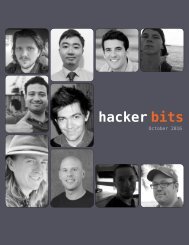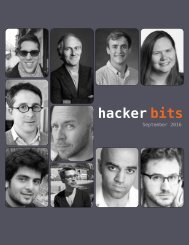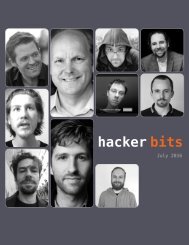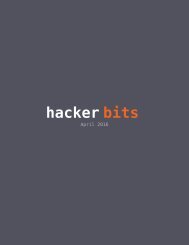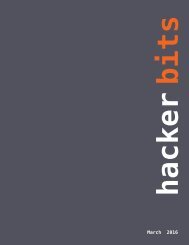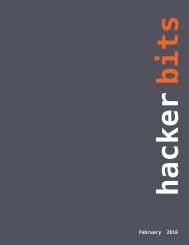Hacker Bits, August 2016
HACKER BITS is the monthly magazine that gives you the hottest technology stories crowdsourced by the readers of Hacker News. We select from the top voted stories and publish them in an easy-to-read magazine format. Get HACKER BITS delivered to your inbox every month! For more, visit https://hackerbits.com/2016-08.
HACKER BITS is the monthly magazine that gives you the hottest technology stories crowdsourced by the readers of Hacker News. We select from the top voted stories and publish them in an easy-to-read magazine format.
Get HACKER BITS delivered to your inbox every month! For more, visit https://hackerbits.com/2016-08.
Create successful ePaper yourself
Turn your PDF publications into a flip-book with our unique Google optimized e-Paper software.
Figure 1: PayPal's change password page<br />
Ok, you get a message<br />
which is nice, but zero info on<br />
why you shouldn’t be pasting in<br />
your password. I’ll come back<br />
to this example later on though<br />
because there are other things<br />
going on here which help explain<br />
their rationale.<br />
Before we go on though,<br />
let’s take a quick look at the<br />
mechanics behind the anti-paste<br />
mechanism so we can better understand<br />
what goes into saving<br />
us from ourselves.<br />
The mechanics of an<br />
anti-password-paster<br />
Right, let’s drill into this and<br />
see what’s going on behind the<br />
scenes. We’ll pick someone different<br />
this time. Let’s try the Al<br />
Rajhi Bank in Saudi Arabia just<br />
for a change of flavour.<br />
As you can see below, I’ve<br />
typed in a username and pasted<br />
a password:<br />
Yeah, about that password…<br />
anyway, the question remains,<br />
what voodoo is breaking this<br />
most fundamental of behaviours?<br />
For Al Rajhi, it’s very<br />
simple:<br />
<br />
That’s it — the onpaste<br />
event is returning false. Sound<br />
unfamiliar? I mean the onpaste<br />
event? Yes, it’s a thing, here’s a<br />
JSFiddler so you can play with it<br />
yourself.<br />
But there’s also this regarding<br />
the event:<br />
Non-standard event defined<br />
by Microsoft for use<br />
in Internet Explorer.<br />
C’mon guys, we’ve been<br />
down the non-standard implementations<br />
in browsers before<br />
and it always ends in tears.<br />
Thing is though, not only<br />
does it work in IE but it works<br />
in Chrome too. And Safari. And<br />
Firefox. And even if it didn’t,<br />
there are always bright JavaScript<br />
ideas to “hack” the ability<br />
of CTRL-V out of browsers.<br />
The point is that there are<br />
many ways of skinning this cat<br />
and it can be very easy. However,<br />
it’s a conscious decision<br />
— the developer has to say “You<br />
know, I really don’t think people<br />
need a paste facility; I’m gonna<br />
kill it”.<br />
But of course we really<br />
should touch on why people<br />
want to paste into password<br />
fields to begin with, so let’s cover<br />
that now.<br />
Why on earth would<br />
you want to paste a<br />
password anyway?!<br />
The argument of whether you<br />
should use a password or a<br />
passphrase or just let the cat<br />
wander over the keyboard and<br />
see what happens has been well<br />
and truly had, and in the end it<br />
always comes back to this: The<br />
only secure password is the one<br />
you can’t remember.<br />
If you haven’t already<br />
reached this enlightened state<br />
then free yourself from the<br />
shackles of human memory-based<br />
passwords and grab<br />
1Password or KeePass or Last-<br />
Pass.<br />
20 hacker bits








